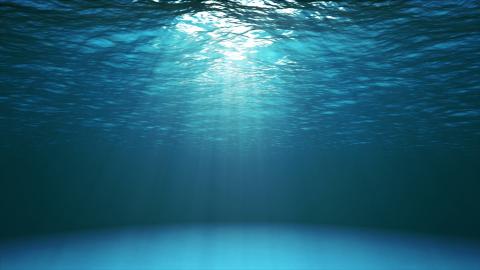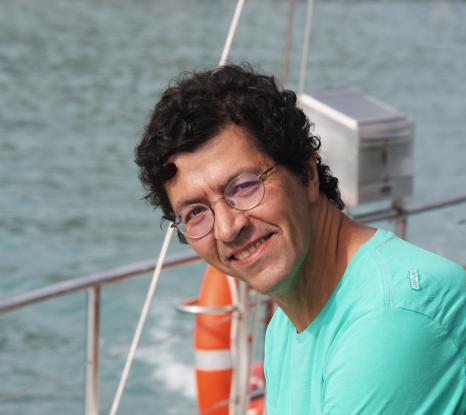
Tribute to Matthieu Roy-Barman: using isotope tracers to understand the ocean
We met with Matthieu Roy-Barman to create this profile a few weeks before his sudden death, on Saturday 19 march, 2022. This profile is a tribute to this great scientist.
Matthieu Roy-Barman was a professor at Université de Versailles – Saint-Quentin-en-Yvelines (UVSQ), a researcher at the Laboratory of Climate and Environmental Sciences (LSCE – Univ. Paris-Saclay, CNRS, CEA, UVSQ) and Director of the Geoscience, Climate, Environment and Planets Graduate School at Université Paris-Saclay. He was a specialist in geochemical tracers in the ocean and used thorium, protactinium and actinium isotopes to study marine particle flows.
Although he spent more than 20 years studying particle flows in the oceans, Matthieu Roy-Barman did not like describing himself as an oceanographer. “I prefer to call myself a geochemist,” he explained. And for good reason, as this precise use of terminology when introducing himself was far from being pretence on his part. It is fact the key to understanding his history as a researcher.
Isotope analysis: from solid earth to fluid envelopes
Matthieu Roy-Barman trained as an engineer at the ‘École nationale supérieure de géologie’ in Nancy and chose to go into research at an early stage. After completing a PhD in fundamental geochemistry at the ‘lnstitut de physique du globe’ in Paris, where he focused on osmium isotopes (187Os / 186Os) and the transfer of matter deep within the Earth, he continued his post-doctoral work at the California Institute of Technology, where he made the first major change of direction in his career. “As I could see few new opportunities in the field of solid envelopes, I decided to reorientate my research towards fluid envelopes over my two years as a post-doctoral student. This didn’t involve me having to change my methodology. I therefore abandoned osmium to concentrate on the analysis of thorium, another isotope present in seawater which can be used as an effective chronometer for the settling speed of marine particles1.” The first results from this shift towards marine geochemistry enabled him to gain a position as an associate professor at Université Paul Sabatier in Toulouse in 1995, where he continued to develop his methods of isotope analysis. Then, in 2001, he joined the Laboratory of Climate and Environmental Sciences (LSCE- Univ. Paris-Saclay, CNRS, CEA, UVSQ) and became an associate professor at Université de Versailles - Saint Quentin-en-Yvelines in 2002, before becoming a professor at the very same university in 2005.
Analysing ever smaller quantities of isotopes
After spending several years focusing on the analysis of thorium and following the funding of a Franco-Swedish project, Matthieu Roy-Barman decided to concentrate his research on protactinium, another isotope, but one which is more sensitive to the circulation of the water masses which he was seeking to better understand. In order to do this, he used samples obtained from an expedition in the Arctic carried out the international Geotraces programme. “As was already the case in my research on thorium, the challenge for me was to be able to analyse ever smaller quantities of isotopes in order to be able to work with reasonable sample sizes2 and thus make it possible for research to progress more quickly in understanding the behaviour of the carbon cycle in the ocean,” the researcher explained. By the end of this project, he and his doctoral students succeeded in measuring quantities of protactinium in the order of femtograms (10-15 grams) per kilogram. “As protactinium precedes actinium in the uranium decay chain, we then decided to take a look at actinium, another interesting, difficult-to-measure tracer. Our goal was to be able to measure actinium using mass spectrometry from samples of ten litres instead of several dozen litres,” added the researcher. Once again, he succeeded in meeting this challenge thanks to his PhD student, Martin Levier, who had just defended a thesis on this subject. “Using 10-litre seawater samples taken in 2008 as part of the Bonus Goodhope expedition in the Atlantic, we were able to develop a method for analysing actinium using mass spectrometry and isotope dilution,” he explained. This was a great step forward which Matthieu Roy-Barman hoped would help to make the measuring of actinium more popular. He had no plans to just stop there. “We’re currently working on the samples taken during the SWINGS oceanographic expedition with the aim of measuring the maximum number of tracers in ten-litre samples,” he said.
Using isotopes to trace lead near Notre-Dame
Although Matthieu Roy-Barman devoted most of his research time to marine geochemistry, he also collaborated with his colleagues on issues in the fields of geoscience and the environment. “For example, I’m occasionally involved in research on the fate of the lead around Notre-Dame de Paris following the fire which took place in April 2019,” the researcher explained. As the ratios of lead isotopes differ depending on the mine from which the lead was extracted, it is possible to identify the traces of lead found around Notre-Dame precisely by measuring the isotopic composition of the lead. “As Paris is a city with a high level of lead present, these studies should make it possible to determine whether or not the presence of lead around the cathedral is a consequence of the fire which took place there,” explained Matthieu Roy-Barman.
At the frontier of communities - a strong sense of community
Matthieu Roy-Barman liked to describe himself as a ‘loner’. However, he did not shy away from taking on increasing amounts of teaching responsibility alongside his research. Together with a number of colleagues, he initiated the creation of the Interaction, Climate and Environment Master's degree, for which he was responsible for thirteen years, and was also Deputy Director and Manager of the Paris-Saclay hub at the Environmental Science, Île-de-France Doctoral School for 5 years. “Teaching has always been a driver for me. I was trained in geology but being a lecturer in oceanography has really helped me to develop, including in my research work. This is why, together with Catherine Jeandel from LEGOS in Toulouse, I was keen to publish Marine Geochemistry in 2011 - a work in which I was able to incorporate all that I’d learnt while lecturing ,” said the researcher.
With his dual background in ‘solid earth’ and ‘fluid envelopes’, Matthieu Roy-Barman also always had the ability to build bridges between communities. It is not surprising, therefore, that after having contributed to the preparatory meetings for the future Graduate Schools at Université Paris-Saclay, he was chosen to be the Director of the Geoscience, Climate, Environment and Planets Graduate School. “While I’ve always enjoyed being at the interface of communities, leading this Graduate School which offers a strongly interdisciplinary approach to the environment is a new experience for me and a real personal challenge. I’m particularly keen to contribute to ensuring that each of the major subject areas underpinning this Graduate School acquires the visibility it deserves and has the necessary resources for its development so that, together, we can boost the momentum which will drive future research,” said the researcher in conclusion.
1 Marine particles carry carbon to the bottom of the ocean when they settle. This is the ocean's 'carbon pump’ - a vital pump for climate regulation.
2 The international teams which work together during offshore expeditions must share the volumes of seawater pumped at specific depths and sites. The volumes available to each team are a few litres. When Matthieu Roy-Barman began this work, several tens of litres were needed to have a chance of analysing the protactinium.
The link to the condolence booklet: https://mensuel.framapad.org/p/hommage-a-matthieu-roy-barman-9t6x

